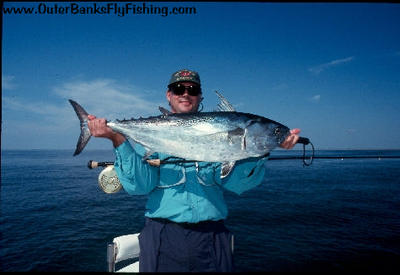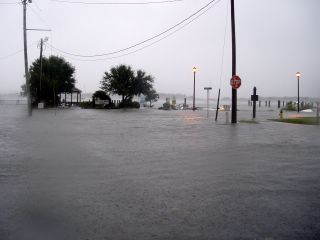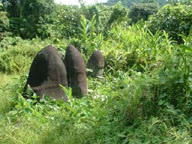Cast Nets, Fall Fishing, Etc.
About 15 years ago, on a lark, I bought a cheap fly fishing outfit-rod, reel, line and instruction book for about $35.00. It was, as the price would indicate, a complete piece of crap, but I was intrigued about the whole thing so one day I got my nerve up and bought an Orvis Rod (a 6 foot, 6 inch, four-weight) to fish the small pocket water streams of Stone Mountain State Park, about an hour from my home. I read as many books as I could, both instructional and otherwise and discovered that fly fishing was not just a way to fish but was more of a way of life and for some, almost a religion. For me it was an escape-a way to see and experience beautiful places and to clear a cluttered mind. Standing in cold, fast moving, boulder strewn water, slinging an imitation of an insect upstream, squinting and following its drift downstream and catching a fleeting glance at a trout dart from behind a rock or other safe place to swallow it was the greatest thing I had ever experienced. It took me an entire year of reading and fishing before I caught my first trout on a fly. I'll remember the exact time, place and details as long as I live. The fish was only hooked for a few seconds until I could release it, but I was hooked permanently. To say I was obsessed with the sport would be a gross understatement. I found a fly shop about 25 miles away and spent countless hours there-picking up and wiggling expensive rods, ogling the shiny expensive reels and watching the assistant manager tie flies. He convinced me to tie my own and that became a separate and distinct obsession-almost as fun as the fishing itself. I tied thousands of flies-ones that would actually catch fish and those that just looked cool and different. I bought every fly patttern book available and still have each one. I bought several more rods and reels and became a fly fishing tackle junkie. I even bought a fly rod for saltwater fishing and managed to catch fish in the surf with it. Sometime in the mid-90's, I met my friend J.P. who was and still is a local cop. He was a big saltwater fly fisherman and while talking about that, he mentioned that he built his own fishing rods. Hell, you could have knocked me over with a feather. I had never given any thought to how fly rods or any other rods were made-I assumed that they were just put together by some machine while rolling down and assembly line. He told me how cheap and easy it was to build your own rod-just adding components to the bare stick of graphite called a "blank." I read some books and catalogs and one day there appeared on my front porch a long PVC tube containing a blank, some guides and a top, a reel seat, a cork grip, some thread and epoxy finish. By following the instructions contained, I sat at my kitchen table and assembled my very first rod. It wasn't very pretty-I've re-done it about 7 times since then-but I caught hundreds and hundreds of fish on that rod. J.P. took me to the Roanoke River near Weldon , N.C. to fish for striped bass making their annual spawning run and we caught over 400 striped bass in two days-on the rod I built with flies I tied. My hands and arms weren't the same for weeks. I still have that rod and still use it-it's very "pretty" now.
Fly fishing at that time was the only type I wanted to do-it was that or nothing. When we moved to the coast in 2000, I still had the same mindset. I soon found out that it was a helluva lot easier to catch fish that were swimming in a 20-foot wide,two-foot deep stream, than to catch them in the expanse of the ocean or sounds. I didn't know where to look and many days were spent futilely flailing away in the surf. Not catching fish made me realize that I was in it for more than just the "purity" of the sport-sure it was fun to cast and have people stare at you as if you were a space alien, but by-god, I wanted to catch something. I found out that the ticket, if you wanted to fish to eat, was live bait. I realized that if you put a live finger mullet, live shrimp or live menhaden on a hook and threw it in the ocean, something would eat the hell out of it and furthermore, you never knew if the fish you caught would be a four-inch pinfish or a hundred pound shark or anything in between. Throw it out and hang on for dear life. I now love fishing with live bait-I have come full circle- substituting live saltwater prey species for worms and crickets. The only thing that has really changed is that I'm still basically a catch and release guy-fly fishing taught me that a gamefish is too beautiful to be caught only once, although I'll keep and eat a flounder without a second thought or a pang of regret.
Knowing how to use a cast net is essential in catching live bait-that and having a live well (a holding tank with a a pump to aerate the water). Cast nets come in various sizes-from a four foot diameter to diameters approaching twenty feet. The bottom of the net is lined with lead weights distributed every inch or so, and of course the larger diameter the cast net, the more weights you have. The weights on a large diameter cast net are also bigger to give it a faster sink rate. A twenty foot cast net is a bitch to throw because of its weight and size, but one correctly heaved over a school of bait might provide enough bait for weeks of fishing. My limit is a ten-foot net and that is stretching it. I prefer a six-foot net with 3/8 inch monofilamient mesh to catch most of my bait up in the creeks. I carry two nets-one which has no holes or broken mesh from entanglement with oyster rocks and another sacrificial net that I don't mind casting into snaggy areas (where the baits like to hide).
My friend Scott taught me how to throw a cast net before I moved to the coast and needed to know how. I was visiting him at his house on Sullivan's Island, just ove the bridge from Charleston, S.C. and it was the first day of shrimp baiting season in their coastal waters. Hell, it might as well have been a national holiday. Everywhere folks were hauling around long pieces of PVC pipe, (referred to as poles-each one sporting a stamp from DNR), ten per person maximum, and buying up large quantities of fish meal and a clay that was black and silver in color. We hauled our clay and fish meal to the side of the house and sat down with a cooler of beer to make the shrimp balls. The clay was mixed with the noxious fish meal into a softball sized orb that dried as hard as concrete. It was hard, stinky work, but necessary in order to have enough to distribute around the poles. The poles were marched out just off the beach and jammed into the soft sand far enough to hold them upright. The fishballs were distributed around the area of the poles and as the clay and fishmeal slowly dispersed, the shrimp were drawn to them by the thousands. In the dark you could hear them start to flip and skitter across the surface of the calm surf. The white poles stood out in contrast against the black sky and marked the area that the shrimp would inhabit. Since I was from out of state and the penalty for an out-of stater shrimping in S.C. waters without a $500.00 license was the the equivalent of public flogging, I was relegated to helping put the shrimp in the buckets after they were netted. Scott, however, gave me my first, and only cast net throwing lesson in the yard of that home and I have never forgotten the basics-place the wrist-loop over your right wrist and coil the remainder, holding it also in the
 right hand. Grab the plastic "horn" with your left hand, allowing the net to droop to its full length and straighten out. Make sure all the weights are hanging to the same level. Grab down from the horn about a foot and a half with your right hand (all the while holding the rope) and drape the part above your right hand over your right shoulder. With your left ha
right hand. Grab the plastic "horn" with your left hand, allowing the net to droop to its full length and straighten out. Make sure all the weights are hanging to the same level. Grab down from the horn about a foot and a half with your right hand (all the while holding the rope) and drape the part above your right hand over your right shoulder. With your left ha nd, grab the leadline and place the leadline in your mouth holding it lightly with your front teeth. Next grab the leadline forward and feed it toward you, grabbing it further and further out. Then grab the leadline up with your left hand and prepare to throw. The throw is unnatural-a motion like that of a pitcher hurling a screwball or a track person throwing a discuss. If you were to imagine the net as a large steering wheel, the technique would be to throw the net outward toward the target while making a violent counterclockwise motion-right hand moving to the
nd, grab the leadline and place the leadline in your mouth holding it lightly with your front teeth. Next grab the leadline forward and feed it toward you, grabbing it further and further out. Then grab the leadline up with your left hand and prepare to throw. The throw is unnatural-a motion like that of a pitcher hurling a screwball or a track person throwing a discuss. If you were to imagine the net as a large steering wheel, the technique would be to throw the net outward toward the target while making a violent counterclockwise motion-right hand moving to the  top rotating counterclockwise and the left hand moving underneath in the same direction-Oh, yeah- let the net slip out of your teeth as you throw! Scott showed me the rudiments and I made some half-ass casts on the grass and then didn't throw another net for a couple years-but I never forgot the technique and the lesson. Constant practice makes perfect or something approaching that and now I can throw one at about a five-handicap- Plenty good for my needs.
top rotating counterclockwise and the left hand moving underneath in the same direction-Oh, yeah- let the net slip out of your teeth as you throw! Scott showed me the rudiments and I made some half-ass casts on the grass and then didn't throw another net for a couple years-but I never forgot the technique and the lesson. Constant practice makes perfect or something approaching that and now I can throw one at about a five-handicap- Plenty good for my needs.The best time to catch bait is at low tide. Bait is forced out of the grass and concentrated in less water. Visual signs are everywhere if you know what to look for-finger mullet swim in schools and make a "V" wake. Shrimp skip and skitter across the surface
 and the movement of a boat in their presence makes them move furiously. Menhaden swim in huge schools and appear as a dark, oily shadow on the surface. They also flip on the surface and
and the movement of a boat in their presence makes them move furiously. Menhaden swim in huge schools and appear as a dark, oily shadow on the surface. They also flip on the surface and can be spotted hundreds of yards away. There are always rogue baits that end up in the net-pinfish and croakers travel with the other bait and are a curse-the pinfish are hard to cull out without them finning you and the croakers tend get so stuck in the net that it's hard to pull them out alive. There's always a surprise-I've caught fishing gear, oysters and once a surprised turtle ended up in the net. We didn't get out last Sunday until after lunch-the tide was high and the bait was scarce or at least hard to find. We motored to the very end of a tidal creek off the Intracoastal, all the way back to the highway and I threw the net in a pocket that looked "dead." To my surprise, the net came back filled with about twenty small menhaden and five or six mullet. My search for shrimp yielded only several small ones and those were tossed back. During my cast net throwing I also pulled up several huge mullet, a 12 inch redfish, some crabs and some silversides. The last hour of the day we spent anchored in the mout
can be spotted hundreds of yards away. There are always rogue baits that end up in the net-pinfish and croakers travel with the other bait and are a curse-the pinfish are hard to cull out without them finning you and the croakers tend get so stuck in the net that it's hard to pull them out alive. There's always a surprise-I've caught fishing gear, oysters and once a surprised turtle ended up in the net. We didn't get out last Sunday until after lunch-the tide was high and the bait was scarce or at least hard to find. We motored to the very end of a tidal creek off the Intracoastal, all the way back to the highway and I threw the net in a pocket that looked "dead." To my surprise, the net came back filled with about twenty small menhaden and five or six mullet. My search for shrimp yielded only several small ones and those were tossed back. During my cast net throwing I also pulled up several huge mullet, a 12 inch redfish, some crabs and some silversides. The last hour of the day we spent anchored in the mout h of the creek. Jane read her magazines and I lobbed a couple of menhaden rigged underneath popping corks up into a small cove. We drank a couple of beers and while I was rigging up another line Jane shouted that one of the rods was bent double. I heard the drag sing, grabbed the rod and felt the pressure. I tightened up on it so the fish wouldn't run up into the oysters and break off and the fish boiled on the surface about 100 feet from the boat. I horsed him in, Jane took some pics and he was released back-a healthy redfish, copper colored with the tell-tale spot on the tail. Minutes later I had another on but he got off the hook- a long distance release. A detour on the way home to
h of the creek. Jane read her magazines and I lobbed a couple of menhaden rigged underneath popping corks up into a small cove. We drank a couple of beers and while I was rigging up another line Jane shouted that one of the rods was bent double. I heard the drag sing, grabbed the rod and felt the pressure. I tightened up on it so the fish wouldn't run up into the oysters and break off and the fish boiled on the surface about 100 feet from the boat. I horsed him in, Jane took some pics and he was released back-a healthy redfish, copper colored with the tell-tale spot on the tail. Minutes later I had another on but he got off the hook- a long distance release. A detour on the way home to
 find some shrimp for the grill went for naught. It was a great day on the water for an ex-fly fishing "purist." Worms, crickets, shrimp, mullet or flies-whatever. It's all good.
find some shrimp for the grill went for naught. It was a great day on the water for an ex-fly fishing "purist." Worms, crickets, shrimp, mullet or flies-whatever. It's all good.


























